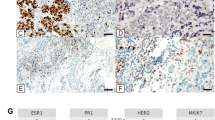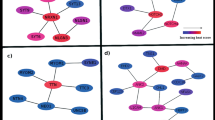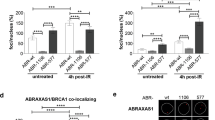Abstract
Expression of deletion mutants of the breast and ovarian cancer-specific tumor suppressor protein, BRCA1, in the mammary epithelial cell line MCF10A revealed a powerful growth suppressive effect by a mutant that has the amino-terminal 302 amino acids deleted (ΔN-BRCA1). The growth suppression is associated with an increase in apoptosis and amplification in centrosome number. The growth inhibitory effect of ΔN-BRCA1 was not observed in cervical epithelial HeLa cells, suggesting that the phenotypes of BRCA1 mutant proteins differ depending on the cell line being tested. An internal domain, including BRCA1 residues 303–1292, caused the suppression of MCF10A cell growth, and the amino terminus of BRCA1 autoinhibited the growth suppression. Single point mutations that disrupted the amino-terminal RING domain of BRCA1 caused significant suppression of growth in MCF10A cells. These results suggest that the proper function of the RING domain, likely to be ubiquitin ligase function, is important in regulating the growth of the mammary epithelial cell line and in autoregulating the powerful internal growth-inhibiting domain of the BRCA1 tumor suppressor.
This is a preview of subscription content, access via your institution
Access options
Subscribe to this journal
Receive 50 print issues and online access
$259.00 per year
only $5.18 per issue
Buy this article
- Purchase on SpringerLink
- Instant access to full article PDF
Prices may be subject to local taxes which are calculated during checkout






Similar content being viewed by others
References
Anderson SF, Schlegel BP, Nakajima T, Wolpin ES and Parvin JD . (1998). Nat. Genet., 19, 254–256.
Andrews HN, Mullan PB, McWilliams S, Sebelova S, Quinn JE, Gilmore PM, McCabe N, Pace A, Koller B, Johnston PG, Haber DA and Harkin DP . (2002). J. Biol. Chem., 277, 26225–26232.
Bochar DA, Wang L, Beniya H, Kinev A, Xue Y, Lane WS, Wang W, Kashanchi F and Shiekhattar R . (2000). Cell, 102, 257–265.
Castilla LH, Couch FJ, Erdos MR, Hoskins KF, Calzone K, Garber JE, Boyd J, Lubin MB, Deshano ML, Brody LC, Collins FS and Weber BL . (1994). Nat. Genet., 8, 387–391.
Chen A, Kleiman FE, Manley JL, Ouchi T and Pan ZQ . (2002). J. Biol. Chem., 277, 22085–22092.
Chiba N and Parvin JD . (2001). J. Biol. Chem., 276, 38549–38554.
Chiba N and Parvin JD . (2002). Cancer Res., 62, 4222–4228.
Dong Y, Hakimi MA, Chen X, Kumaraswamy E, Cooch NS, Godwin AK and Shiekhattar R . (2003). Mol. Cell, 12, 1087–1099.
Friedman LS, Ostermeyer EA, Szabo CI, Dowd P, Lynch ED, Rowell SE and King MC . (1994). Nat. Genet., 8, 399–404.
Haile DT and Parvin JD . (1999). J. Biol. Chem., 274, 2113–2117.
Hashizume R, Fukuda M, Maeda I, Nishikawa H, Oyake D, Yabuki Y, Ogata H and Ohta T . (2001). J. Biol. Chem., 276, 14537–14540.
Hsu LC, Doan TP and White RL . (2001). Cancer Res., 61, 7713–7718.
Hu YF, Hao ZL and Li R . (1999). Genes Dev., 13, 637–642.
Kleiman FE and Manley JL . (2001). Cell, 104, 743–753.
Ko LJ and Prives C . (1996). Genes Dev., 10, 1054–1072.
MacLachlan TK, Somasundaram K, Sgagias M, Shifman Y, Muschel RJ, Cowan KH and El-Deiry WS . (2000). J. Biol. Chem., 275, 2777–2785.
Miki Y, Swensen J, Shattuck-Eidens D, Futreal PA, Harshman K, Tavtigian S, Liu Q, Cochran C, Bennett LM, Ding W, Bell R, Rosenthal J, Hussey C, Tran T, McClure M, Frye C, Hattier T, Phelps R, Haugen-Strano A, Katcher H, Yakumo K, Gholami Z, Shaffer D, Stone S, Bayer S, Wray C, Bogden R, Dayananth P, Ward J, Tonin P, Narod S, Bristow PK, Norris FH, Helvering L, Morrison P, Rosteck P, Lai M, Barrett JC, Lewis C, Neuhausen S, Cannon-Albright L, Goldgar D, Wiseman R, Kamba A and Skolnick MH . (1994). Science, 266, 66–71.
Moynahan ME, Chiu JW, Koller BH and Jasin M . (1999). Mol. Cell, 4, 511–518.
Narita T, Yamaguchi Y, Yano K, Sugimoto S, Chanarat S, Wada T, Kim DK, Hasegawa J, Omori M, Inukai N, Endoh M, Yamada T and Handa H . (2003). Mol. Cell. Biol., 23, 1863–1873.
Neish AS, Anderson SF, Schlegel BP, Wei W and Parvin JD . (1998). Nucleic Acids Res., 26, 847–853.
Paull TT, Cortez D, Bowers B, Elledge SJ and Gellert M . (2001). Proc. Natl. Acad. Sci. USA, 98, 6086–6091.
Schlegel BP, Green VJ, Ladias JA and Parvin JD . (2000). Proc. Natl. Acad. Sci. USA, 97, 3148–3153.
Schlegel BP, Starita LM and Parvin JD . (2003). Oncogene, 22, 983–991.
Scully R, Anderson SF, Chao DM, Wei W, Ye L, Young RA, Livingston DM and Parvin JD . (1997). Proc. Natl. Acad. Sci. USA, 94, 5605–5610.
Scully R, Ganesan S, Vlasakova K, Chen J, Socolovsky M and Livingston DM . (1999). Mol. Cell, 4, 1093–1099.
Snouwaert JN, Gowen LC, Latour AM, Mohn AR, Xiao A, DiBiase L and Koller BH . (1999). Oncogene, 18, 7900–7907.
Somasundaram K, Zhang H, Zeng YX, Houvras Y, Peng Y, Wu GS, Licht JD, Weber BL and El-Deiry WS . (1997). Nature, 389, 187–190.
Starita LM and Parvin JD . (2003). Curr. Opin. Cell Biol., 15, 345–350.
Wu LC, Wang ZW, Tsan JT, Spillman MA, Phung A, Xu XL, Yang MC, Hwang LY, Bowcock AM and Baer R . (1996). Nat. Genet., 14, 430–440.
Wu-Baer F, Lagrazon K, Yuan W and Baer R . (2003). J. Biol. Chem., 278, 34743–34746.
Xia Y, Pao GM, Chen HW, Verma IM and Hunter T . (2003). J. Biol. Chem., 278, 5255–5263.
Xu X, Weaver Z, Linke SP, Li C, Gotay J, Wang XW, Harris CC, Ried T and Deng CX . (1999). Mol. Cell, 3, 389–395.
Zhong Q, Chen CF, Li S, Chen Y, Wang CC, Xiao J, Chen PL, Sharp ZD and Lee WH . (1999). Science, 285, 747–750.
Acknowledgements
This project was supported by research Grant CA90281 from the National Cancer Institute (JDP), by fellowship DAMD17-00-0164 from the Department of Defense Breast Cancer Research Program (FY), and a grant in Aid from the Tokyo Biochemical Research Foundation and the Kanzawa Medical Research Foundation (NC).
Author information
Authors and Affiliations
Corresponding author
Rights and permissions
About this article
Cite this article
You, F., Chiba, N., Ishioka, C. et al. Expression of an amino-terminal BRCA1 deletion mutant causes a dominant growth inhibition in MCF10A cells. Oncogene 23, 5792–5798 (2004). https://doi.org/10.1038/sj.onc.1207739
Received:
Revised:
Accepted:
Published:
Issue date:
DOI: https://doi.org/10.1038/sj.onc.1207739
Keywords
This article is cited by
-
Wwox–Brca1 interaction: role in DNA repair pathway choice
Oncogene (2017)
-
DNA repair capacity is impaired in healthy BRCA1 heterozygous mutation carriers
Breast Cancer Research and Treatment (2015)
-
A critical role of integrin-linked kinase, ch-TOG and TACC3 in centrosome clustering in cancer cells
Oncogene (2011)
-
BRCA1a has antitumor activity in TN breast, ovarian and prostate cancers
Oncogene (2007)
-
Rab11a Differentially Modulates Epidermal Growth Factor-induced Proliferation and Motility in Immortal Breast Cells
Breast Cancer Research and Treatment (2006)



